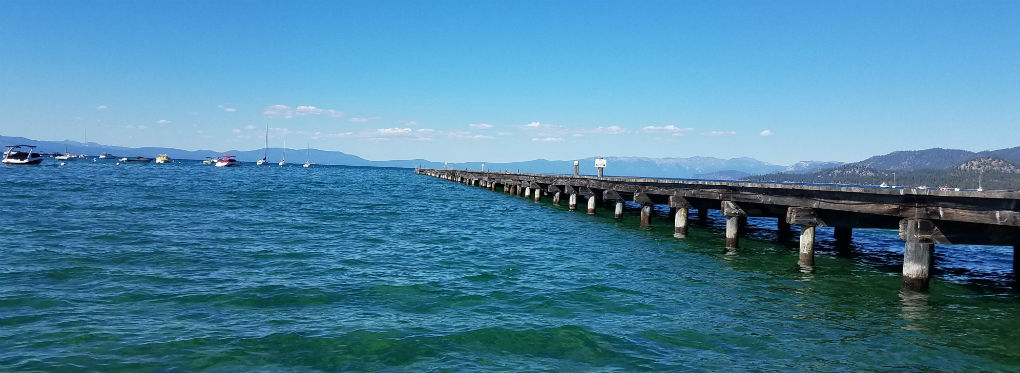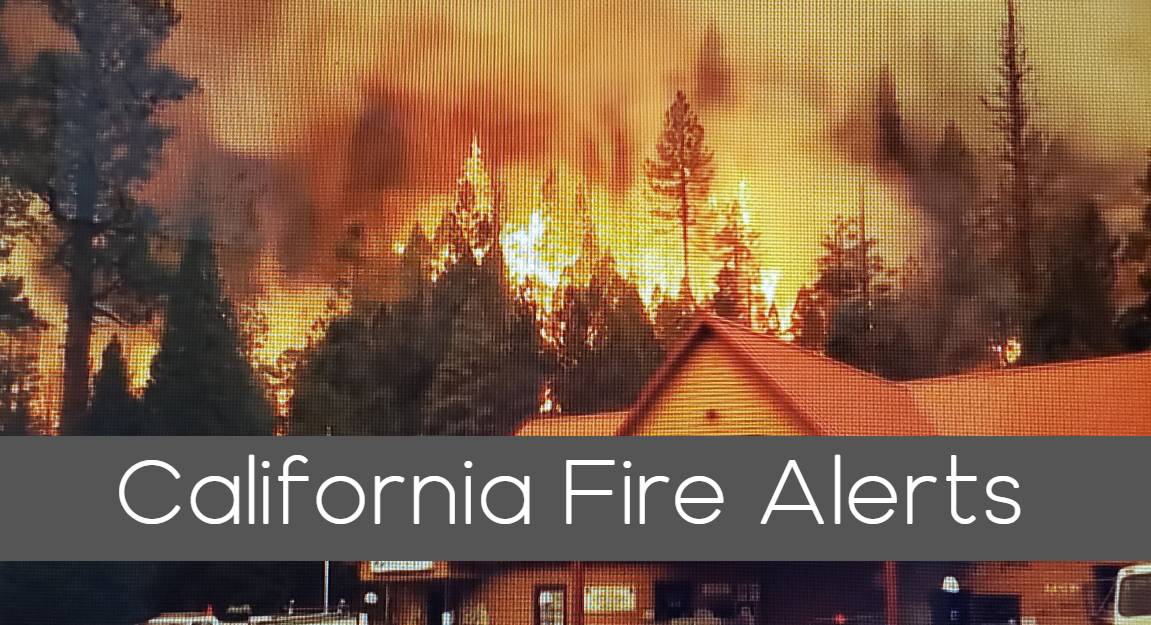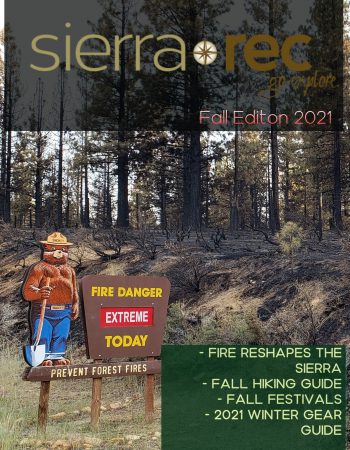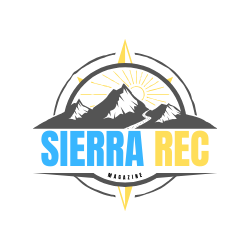CALIFRNIA FIRE HISTORY BEING REWRITTEN IN PAST TWO YEARS.
The Sierra Nevada – September 2021 , Fall 2021 issue – As August 2021 comes to a close we have tremendous fire dangers in some of California’s most prized destinations. South Lake Tahoe is being evacuated because of the Caldor fire, the Dixie fire has numerous communities evacuated and we completely last the town of Greenville Ca.
To date 2021 fire season has torched over 1.2 million acres of forest land in the Sierra Nevada regions alone. The Dixie Fire now at 771,000 acres, the Caldor fire at 177,000 acres and the Tamarack Fire at 68,000 acres, being he largest of the three fires in the Sierra Nevada. We have seen communities and recreational areas completely changed over night in 2021. The Dixie fire and Caldor Fire are now ranked #2 and #17 currently on the top 20 largest California fires of all time.
So how does this fire season compare to our history? We took a look back at Cal-fire statistics for the past 5 years and were astonished at the pace in which the five year average is being changed historically across the state of California. Although you can find fire seasons that compare over the past 50 years, you cant compare the current five year stretch with any time in California history. We are just by pure statistics in a time of historic change. As a matter of fact you could argue that this is actually a 10 year record pace as since 2012 we have lost no fewer than 650,000 acres to forest fire in the State of California in any one year.
In the past five years California has seen Fire seasons by acreage burned as the following:
- 2017 1,548,000 acres Burned
- 2018 1,975,000 acres Burned
- 2019 1, 018,000 Acres Burned
- 2020 4,257,000 Acres Burned
- 2021 1,700,000 Est To Date Burned
While wildfires are a natural part of California’s landscape, the fire season in California and across the West is starting earlier and ending later each year. Climate change is considered a key driver of this trend. Warmer spring and summer temperatures, reduced snowpack, and earlier spring snowmelt create longer and more intense dry seasons that increase moisture stress on vegetation and make forests more susceptible to severe wildfire. The length of fire season is estimated to have increased by 75 days across the Sierras and seems to correspond with an increase in the extent of forest fires across the state. Of course climate change is met with historical changes in fire and land management as well, Our forests are kindling box of fuel from the type of forest management that has been deployed and the pure lack of numbers available in employee coverage to do things like controlled burns, logging, thinning etc.
After 5 years of record forest fires and millions of property damage and loss, many are calling for significant change to the management of our public lands. Time will tell if peoples voices will be heard by those who make policy and set budgets. At this time it is easy for the public to launch anger at local forest service management but fail to realize they are only working with in the budgets given. And in the case of South Lake Tahoe, most of their time in the summers are spent cleaning up after guests that have no moral compass in the fight to keep things natural.

The 2020 California wildfire season was characterized by a record-setting year of wildfires that burned across the state of California as measured during the modern era of wildfire management and record keeping. As of the end of the year, nearly 10,000 fires had burned over 4.2 million acres, more than 4% of the state’s roughly 100 million acres of land, making 2020 the largest wildfire season recorded in California’s modern history. California’s August Complex fire has been described as the first “gigafire” as the area burned exceeded 1 million acres.
In 2020 the Creek fire devastated a good portion of the Sierra range. In July 2021 The Forest Service announced the results of the investigation into the cause of the Creek Fire, a wildfire that began on September 4, 2020, and burned approximately 379,895 acres, destroyed 853 structures, and damaged an additional 64 structures on the Sierra National Forest below Big Creek.
Despite an exhaustive investigation, the cause of the fire is officially categorized as “undetermined.” Fire investigators determined that the most probable cause was a lightning strike. An “undetermined” status is not uncommon given the complexities involved.
Sierra Recreation Impact
As we focus on the Sierra Nevada and the Mountain regions that make up the California/ Nevada Borders we start to get a better scope of the recreational and life changes that fire has started to create over the past 5 years. Lets take a look at Fires greater than 2000 acres only over the past 5 years.
2017 Fires Greater Than 2000 Acres
- Eureka Fire – Plumas County 2, 575 acres
- Minerva fire – Plumas County 4,310 acres
- Slinkard Fire – Mono county – 8,925 acres
- Empire Fire – Mariposa County – 8,094 acres
- Detwiler fire – Mariposa County – 81,826 acres
- South Fork Fire – Mariposa County – 7,000 acres
- Lion Fire – Tulare County 18,900 acres
- Pier Fire – Tulare County – 36,556 acres
- Indian fire -Tulare County – 2,295 acres
- Roadrunner fire – Tulare County – 2,285 acres
- Summit Complex Fire – Stanislaus County – 5,247 acres
- Railroad Fire – Madera County – 12,406 acres
- Long valley fire – Lassen County – 83,733 acres
- r-4 fire – Lassen County – 18,618 acres
- Mud Fire – Lassen County – 6,042 acres
In terms of property damage, 2017 was the most destructive wildfire season on record in California at the time. However in the Sierra Recreational region the effects were minimal compared to the rest of the State of California.
2018 Fires Greater Than 2000 Acres
- Camp Fire – Butte county – 153,336 acres
- Georges Fire – Inyo County – 2,883 acres
- Pleasant fire – Inyo County – 2,073 acres
- Whaleback Fire – Lassen County – 18,703 acres
- Lions Fire – Madera County – 4,064 acres
- Ferguson fire – Mariposa County – 96,901 acres
- Boot Fire – Mono county – 6,974 acres
- Donnell Fire – Tuolumne County – 36,450 acres
The 2018 wildfire season was the deadliest and most destructive wildfire season on record in California, with a total of over 7,500 fires burning an area of over 1,670,000 acres, the largest area of burned acreage recorded in a fire season. The Camp fire which Paradise Ca, may be one of the most devastating community fires the sierra region has ever seen.
2019 Fires Greater Than 2000 Acres
- Caples Fire – Eldorado County – 3,435 acres
- Taboose fire – Inyo County – 10,296 acres
- Cow fire – Inyo county – 1,995 acres ( close enough)
- R1- Fire- Lassen County – 3,380 acres
- Long Valley fire – Lassen County – 2,438 acres
- Briceberg Fire – Mariposa County – 5, 563 acres
- Springs fire – Mono County – 4,840 acres
- Walker Fire – Plumas County – 54,612 acres
- Rock Fire – Stanislaus County – 2,422 acres
- In comparison with the destructive years which preceded it, 2019 was a relatively mild fire season. With only the Walker Fire in Plumas doing significant damage in the region.
2020 Fires Greater Than 2000 Acres
- North Complex Fire – Lassen and Plumas- 318,935 acres
- Claremont fire -20,697 acres
- Bear Fire – 12,154 acres
- Gold Fire – Lassen County – 22,634 Acres
- Hog Fire – Lassen County – 9,564 acres
- Sheep Fire – Plumas County – 29,570 acres
- Loyalton fire – Sierra County – 47,029 acres
- The Castle Fire – Sequoia National Park –
- SQF Complex Fire – 174,178 acres
- Giant Sequoia National Monument (131,087acres)
- Inyo National Forest (12,508 acres)
- Sequoia National Park (18,984 acres)
- Bureau of Land Management (736 acres)
- State (4,017 acres)
- County, and private lands (4,004 acres)
The 2020 California wildfire season was characterized by a record-setting year of wildfires that burned across the state of California as measured during the modern era of wildfire management and record keeping. As of the end of the year, nearly 10,000 fires had burned over 4.2 million acres, more than 4% of the state’s roughly 100 million acres of land, making 2020 the largest wildfire season recorded in California’s modern history. California’s August Complex fire has been described as the first “gigafire” as the area burned exceeded 1 million acres. The SQF Complex Fire nearly crossed the entire Sierra Range from Sequoia to the Western flanks of Mammoth Ca.
2020 Fires Greater Than 2000 Acres (To Date – August 30, 2021)
- Tamarack Fire – Alpine County – 68,637 acres*
- Dixie fire – Plumas, Lassen , Shasta counties- 771, 183 acres*
- Caldor Fire – Eldorado County – 177, 260 Acres*
- River Fire – Mariposa county – 9,656 Acres
- Dexter Fire – Mono County – 2,965 acres
- River Fire – Nevada/ Placer counties – 2,619 acres
- * Red letters = Still Burning
The list seems shorter for the Sierra in 2021. however this is a devastating year based on location of these fires. Towns of Markleville, Kyburz, South Lake Tahoe, Greenville, Lake Almanor, Quincy, Lassen Volcanic national Park, Chester ca and more all have had to evacuate and many homes and structures lost. These fires have destroyed National Scenic Byways, National Park Land and Wilderness areas that are designated and protected lands.

It may also be of note the elevation of which these fires are burning which similar to the SQF fire in 2020 is destroying land that not only is resource deprived as it is, but have delicate meadows and features that feed our water systems. These areas will have a much more difficult time in recovery.
In the Plumas region years of trail systems that were being developed to connect the northern communities and to bring world class mountain biking to the area may have been lost in the Dixie fire. This work provided by grants can still be accomplished but the latest fires have put this project on hold, which means communities which have been banking on the new tourism dollars or employment opportunities lose out and have to struggle even further to reach their dreams. Towns such as Greenville ca, may never recover as employment in the region just may not make it viable for established living styles in the state. Time and conviction will playout in the north when winter arrives and the Dixie fire is finally contained.
For the Tahoe region the Tamarack and Caldor fires come at an interesting time in its history. Current residents are already embattled with local authorities over the “over tourism effects o the lake and wilderness regions. Covid -19 and Instagram fame brought a surge of tourism to the area leaving many undesirable results in trash, graffiti, and traffic. As the Lake area close in the region there were remnants of the public that could almost be heard cheering the turning away of tourism visitors. Once these fires stop and he destruction is evaluated, the internal battle will resume on the impacts that Tourism is having on the local economy and on the local landscape.
The forest will recover from this five-ten year stretch in the Sierra. hikers and Mountain bikers and campers will return to the forest. But you cant argue that the area will not be the same. World history may mark this time in life as a period that the Sierra changed because of the very nature that fire provides. Renewed life, Changed landscapes and re-built natural flow.
Sierra Rec Magazine has been publishing since 2012 and has focused on sharing the news, highlights and events that make this such a great region to visit, play within and live. Please help support local journalism and local community each time you visit the Sierra. Discover more at sierrarec.mystagingwebsite.com or join us on social media on Instagram, Facebook, Twitter, or YouTube









